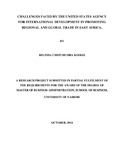| dc.description.abstract | Good intentions to encourage business initiatives are seen in both the private sector and the
donor community. However, both sectors need to make sure that they are fulfilling their
mandates and commitments to society in order to ensure goals are achieved. Dynamic challenges
are an important element to consider in organizations and the solutions to these challenges
should be constantly sought out in order to exploit the potential that exists in every trading
platform. Mutual relationships between business organizations and donors can lead to eradication
of real life challenges that are an impediment to smooth international trade both locally and
internationally. The objective of this study was to establish the challenges faced by USAID
PATA in encouraging trade regionally and internationally. The study looked at different the
concept of international trade, regionalization, global trade and narrowed it down to the East
African Community‟s regional trade. Thereafter, the study gave a brief background to the United
States Agency for International Development (USAID)‟s work through the Power Africa Trade
Africa (PATA) initiative in East Africa and through the African Growth and Opportunity Act
(AGOA). The study looked at the Uppsala Model and the Innovation – Related
Internationalization Model as the theoretical framework. In addition to this, the factors that have
generally been found to affect international trade were discussed. The major factors were Tariffs,
Subsidies, Import Quotas and Voluntary Export Restraints, Local Content Requirements and
Non-tariff Barriers. The study adopted a case study research design and used primary data
through an interview guide and analysed the same through content analysis. It was found that the
major challenges that USAID PATA faces in East Africa are poor infrastructure, nationalism,
non-tariff barriers to trade and exorbitant customs fees challenges. The study showed that
USAID PATA provides technical assistance support such as financial models and analysis,
governance interventions and operation manuals that include feedback mechanisms. In this way,
the donor recipient organizations are able to operate efficiently and gain competitive advantage
as they trade in the region and abroad. It was found that USAID PATA cannot achieve its trade
objectives on its own without the donor recipient organizations that are involved in actively
encouraging the smooth flow of trade within the region and abroad. USAID PATA benefits from
the various relationships with ACTIF, Trademark East Africa, Maersk and Mohazo Limited. The
study concluded that intentional political will, a change in mind-sets within East Africa to
embrace a single customs territory will eradicate the challenges currently being faced by
businesses in Kenya and East Africa. This includes all stakeholders working together to
eliminate the challenges to trade. If one challenge is tackled in isolation, it shows up in a
different form elsewhere within the system. A multi-pronged approach is needed in dealing with
the dynamic challenges that come up in order to maximize on short term, easy to reach solutions
and engage what may seem to be more complicated, long term solutions to challenges. It was
found that the benefits outweigh the challenges in international trade as East Africa opens up to
the world. This has been found to result from the mutually beneficial relationship between
USAID PATA and various trade organizations with head offices in Kenya. | en_US |

